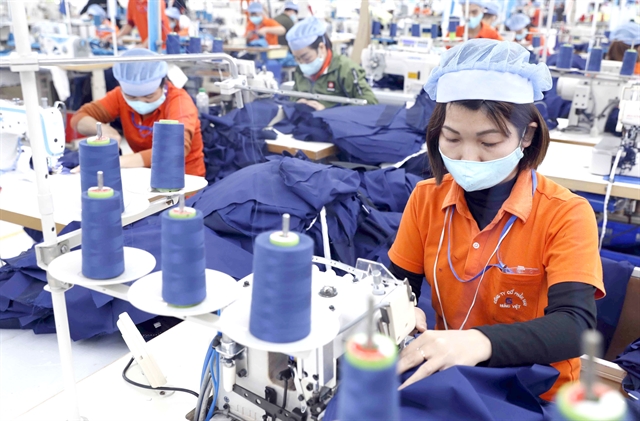 Society
Society

Up to 69.2 per cent of people faced income reductions, 39.9 per cent had to cut working hours and take time off work, and about 14 per cent had to stop working altogether.

|
| A worker at the apparel and clothing company Hưng Việt, based in the northern province of Hưng Yên, with Japan being its main export market. — VNA/VNS Photo Trần Việt |
HÀ NỘI — The labour market in the fourth quarter of 2020 showed many signs of improvement compared to the previous quarter, but many in Việt Nam still suffered from job or income losses, according to the General Statistics Office of Việt Nam (GSO).
In Wednesday meeting reviewing the labour market situation of the fourth quarter and whole of 2020, GSO noted that as of December, there were are 32.1 million people aged 15 years and over negatively affected by the COVID-19 pandemic, including losing their jobs, taking time off work, and reducing working hours.
Up to 69.2 per cent of people faced income reductions, 39.9 per cent had to cut working hours and take time off work, and about 14 per cent had to stop working altogether.
The service sector was most affected by the pandemic with 71.6 per cent of workers affected, followed by industry and construction with 64.7 per cent, and the agriculture, forestry and fishery sector with 26.4 per cent.
The labour force aged 15 and over in the fourth quarter of 2020 was 55.1 million people, an increase of 563,800 people compared to the previous quarter, but lower than the same period of 2019.
This once again confirmed the recovery of the labour market after recording a decline in the second quarter of 2020.
Generally in 2020, the labour force aged 15 and over reached 54.6 million people, a decrease of 1.2 million people compared to 2019.
Out of the 1.2 million people pushed into unemployment, 51.6 per cent were women and most of them of working age.
In the 2016-2019 period, the average annual labor force increased 0.8 per cent. If the workforce in 2020 maintained the same growth rate as in the 2016-2019 period and there was no COVID-19 pandemic, Việt Nam’s economy would have 1.6 million more employees.
In other words, the pandemic has deprived 1.6 million people of the opportunity to enter the labour market.
Average monthly income of employees in the fourth quarter of 2020 reached VNĐ5.7 million (US$247), up VNĐ212,000 (US$9.1) against the previous quarter and down VNĐ108,000 from the same period of 2019.
GSO’s recommendations
For the first time in 10 years, Việt Nam’s economy has witnessed a serious decline in the number of people entering the labour market and the number of people employed.
The average income of workers was also down. The indicators on the unemployment rate, underemployment rate and the rate of workers with informal jobs have all increased in contrast to the decreasing trend in recent years.
With the development of the COVID-19 pandemic, especially a new variant of the virus that has a higher spread, the effects of the disease on life and production will be very unpredictable.
In order to proactively respond and adapt to the evolution of the pandemic to both control the pandemic and promote production and business, it is necessary to carry out several measures and policies.
First, the government should offer policies to help businesses overcome difficulties and avoid bankruptcy as well as help labourers keep their jobs. The policies will also motivate production and business development.
Second, the government should further deploy assistance packages, diversify forms of assistance and open more vocational training programmes, especially for female labourers, manual labourers and part-time labourers, contributing to social welfare stabilisation and economic recovery from the pandemic.
At present, about 75 per cent of the Vietnamese labour force are not trained. This is a major limitation of the Vietnamese economy in the context of a pandemic still spreading and the fourth industrial revolution taking place around the world.
The low quality of the labour force will be a barrier of opportunities to adapt and catch up with new technology trends and new business methods.
Therefore, in the future, Việt Nam needs to actively renew and implement training and retraining policies to improve the quality of human resources to adapt to the requirements of economic growth and development. — VNS